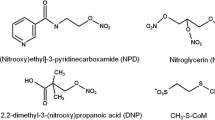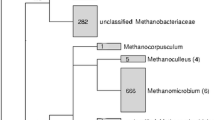Abstract
Inhibition of methanogenesis in ruminal cultures was attempted by hindering thiamine availability through its degradation by ‘polyphenols’ and competition for active sites on enzymes and transporters using thiamine structural analogs. Effects on fermentation were small and not consistently reversed by adding thiamine. Lack of major effects of the compounds evaluated could be due to intracellular synthesis of thiamine covering most requirements.
Similar content being viewed by others
Abbreviations
- CP:
-
crude protein
- SEM:
-
standard error of the mean
- DM:
-
dry matter TPP thiamine diphosphate
- HPLC:
-
high performance liquid chromatography
- VFA:
-
volatile fatty acid
- NDF:
-
neutral detergent fiber
References
Alvarez M.A., Debattista N.B., Pappano N.B.: Antimicrobial activity and synergism of some substituted flavanoids. Folia Microbiol.53, 23–28 (2008).
Alves De Oliveira L., Jean-Blain C., Komisarczuk-Bony S., Durix A., Durier C.: Microbial thiamine metabolism in the rumen simulating fermenter (Rusitec): the effect of acidogenic conditions, a high sulfur level and added thiamine. Brit.J.Nutr.78, 599–613 (1997).
Fukui S., Ohishi O., Kishimoto S., Takamizawa A., Hamazima Y.: Formation of “thiaminosuccinic acid” as an intermediate in the transformation of oxythiamine to thiamine by a thiamineless mutant of Escherichia coli. J.Biol.Chem.240, 1315–1321 (1965).
Goering H.K., Van Soest P.N.:Forage Fiber Analyses (Apparatus, Reagents, Procedures and Some Applications). Agricultural Handbook 379. ARS-USDA, US Government Printing Office, Washington (DC) 1975.
Harmeyer J., Kollenkirchen U.: Thiamine and niacin in ruminant nutrition. Nutr.Res.Rev.2, 201–225 (1989).
Heitmann R.N., Taka M.R.Y.: An in vitro study of the effects of amprolium in the rumen. Mesopotamia J.Agric.5–6, 32–40 (1970–71).
Horman I., Brambilla E.: Are ortho-diphenols antithiamine agents? Ann.N.Y.Acad.Sci.378, 467–468 (1982).
Horton G.M.J., Stockdale P.H.G.: Effects of amprolium and monensin on oocyst discharge, feed utilization, and ruminal metabolism of lambs with coccidiosis. Am.J.Vet.Res.40, 966–970 (1979).
Jalč D., Kišidayová S., Nerud F.: Effect of plant oils and organic acids on rumen fermentation in vitro. Folia Microbiol.47, 171–177 (2002).
Kishi H., Okumoto C., Hiraoka E.: Isolation and properties of mutants of Lactobacillus fermenti resistant to amprolium. J.Vitaminol.17, 59–63 (1971).
Knappe J., Schacht J., Möckel W., Höpner Th., Vetter H. Jr., Edenharder R.: Pyruvate-formate-lyase reaction in Escherichia coli. The enzymatic system converting an inactive form of the lyase into the catalytically active enzyme. Eur.J.Biochem.11, 316–327 (1969).
Kubodera T., Yamashita N., Nishimura A.: Pyrithiamine resistance gene (ptrA) of Aspergillus oryzae: cloning, characterization and application as a dominant selectable marker for transformation. Biosci.Biotechnol.Biochem.64, 1416–1421 (2000).
Liu J.-Y., Timm D.E., Hurley T.D.: Pyrithiamine as a substrate for thiamine pyrophosphokinase. J.Biol.Chem.281, 6601–6607 (2006).
Moss A.R.:Methane. Global Warming and Production by Animals, 1st ed. Chalcombie Publications, Warwickshire (UK) 1993.
Nagaraja T.G., Newbold C.J., Van Nevel C.J., Demeyer, D.I.: Manipulation of ruminal fermentation, pp. 523–617 in P.N. Hobson, C.S. Stewart (Eds): The Rumen Microbial Ecosystem. Blackie Academic & Professional, London 1997.
Olkowski A.A., Laarveld B., Patience J.F., Francis S.I., Christensen D.A.: The effect of sulfate on thiamine-destroying activity in rumen content cultures in-vitro. Internat.J.Vit.Nutr. Res.63, 38–44 (1993).
Pristaš P., Piknová M., Šprinková A., Javorský P.: Genetic variability of rumen selenomonads. Folia Microbiol.53, 165–172 (2008).
Russell J.B., Wallace R.J.: Energy-yielding and energy-consuming reactions, pp. 246–282 in P.N. Hobson, C.S. Stewart (Eds): The Rumen Microbial Ecosystem. Blackie Academic & Professional, London 1997.
Sinha A.K., Chatterjee G.C.: Metabolism of pyrithiamine by the pyrithiamine-requiring mutant of Staphylococcus aureus. Biochem. J.107, 165–169 (1968).
Sudarsan N., Cohen-Chalamish S., Nakamura S., Mitchell Emilsson G., Breaker R.R.: Thiamine pyrophosphate riboswitches are targets for the antimicrobial compound pyrithiamine. Chem.Biol.12, 1325–1335 (2005).
Tafaj M., Schollenberger M., Feofilowa J., Zebeli Q., Steingass H., Drochner W.: Relationship between thiamine concentration and fermentation patterns in the rumen fluid of dairy cows fed with graded concentrate levels. J.Anim.Physiol.Anim. Nutr.90, 335–343 (2006).
Ungerfeld E.M., Rust S.R., Burnett R.: Attempts to inhibit ruminal methanogenesis by blocking pyruvate oxidative decarboxylation. Can.J.Microbiol.49, 650–654 (2003).
Vimokesant S., Kunjara S., Rungruangsak K., Nakornchai S., Panijpan B.: Beriberi caused by antithiamine factors in food and its prevention. Ann.N.Y.Acad.Sci.378, 123–136 (1982).
Voet D., Voet J.G.: Biochemistry, 2nd ed. John Wiley & Sons, New York 1995.
Vogl C., Klein C.M., Batke A.F., Schweingruber M.E., Stolz J.: Characterization of Thi9, a novel thiamine (vitamin B1) transporter from Schizosaccharomyces pombe. J.Biol.Chem.283, 7379–7389 (2008).
Wolin M.J., Miller T.L., Stewart C.S.: Microbe-microbe interactions, pp. 467–491 in P.N. Hobson, C.S. Stewart (Eds): The Rumen Microbial Ecosystem. Blackie Academic & Professional, London 1997.
Woolley D.W., White A.G.C.: Selective reversible inhibition of microbial growth with pyrithiamine. J.Exp.Med.78, 489–497 (1943).
Author information
Authors and Affiliations
Corresponding author
Rights and permissions
About this article
Cite this article
Ungerfeld, E.M., Rust, S.R. & Burnett, R. The effects of thiamine inhibition on ruminal fermentation: a preliminary study. Folia Microbiol 54, 521–526 (2009). https://doi.org/10.1007/s12223-009-0075-9
Received:
Revised:
Published:
Issue Date:
DOI: https://doi.org/10.1007/s12223-009-0075-9




